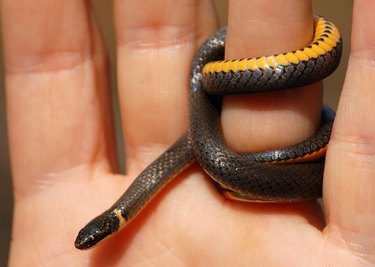
Slithery, scaly snakes can make cool pets that are fun to hold. But when you think of pet snakes, you might think of big boa constrictors or other large snakes that are hard to hold onto even with two hands. But not all snakes are so massive. In fact, the tiny ringneck snake can be held easily in one hand —sometimes even happily curling around just one single finger. As a bonus, while larger snakes take up a ton of room, the ringneck snake often needs a tank only slightly bigger than a shoebox. As a bonus, they eat insects like worms, crickets and slugs rather than mammals like mice, rats or baby bunnies.
About ringneck snakes
Video of the Day
Ringneck snakes are small snakes that live throughout North and Central America, with a territory that spans from Canada all the way through Mexico. As the name implies, the snakes have a distinctive yellow ring on their neck. They have stunning colors that are prized among snake owners, with their backs generally ranging from black to brown to gray and bright stomachs ranging from red to orange to yellow.
Video of the Day
They are small snakes, generally growing to only 10 to 15 inches depending on the subspecies, and they rarely get wider than the width of a pencil. This means that a full-grown ringneck snake pet will be about the size of many other baby snakes. While they are extremely common, these snakes are rarely seen because they are small, very shy, live in the forest, and spend most of their time hiding in places like rocks, logs, and leaf litter.
While the ringneck snake does have venom, the venom does not pose a threat to humans. Additionally, the teeth are small and located in the back of the mouth, according to PetPonder, which means that they cannot get their teeth into your skin. While bites are very rare, when they do occur, Reptile Wikipedia says that they can last up to a minute, and the result is a slight sting and warm sensation. The bites do not hurt.
Getting a ringneck snake pet
Because ringneck snakes are difficult to breed in captivity, most ringneck snakes kept as pets come from the wild, whether they were captured by the owner or a snake dealer. While ringneck snakes are fairly common throughout North and Central America, there are some subspecies that are protected by conservation laws, according to Animal Diversity Web.
These subspecies include the San Diego ringneck snakes and San Bernardino ringneck snakes of Southern California, the Key ringneck snakes of the Florida Keys, and the regal ringneck snakes and Northwestern ringneck snakes of Iowa. Because these subspecies are all threatened in their native environments, their capture and captivity should be avoided.
A baby ringneck snake is born ready to care for himself and does not require help from his parent, so if you happen to stumble upon ringneck snake eggs and can successfully incubate and hatch them, you can raise the hatchlings just like you would an older snake. It is worth noting thought that mostly because of their size and their shy personality, the ringneck snake is very delicate and is not necessarily a good pet for a first-time owner.
Caring for a ringneck snake
Ringneck snake care begins with a proper cage. That means a 10-gallon cage with a mesh top that will stop the snake from escaping. These snakes require plenty of hiding places, so things like hollowed logs and caves are necessary to prevent the snake from feeling stressed. Put 3 inches of potting soil, sand, and peat moss in the cage so the snake can burrow and hide herself, and mist this bedding with a spray bottle every other day in order to keep the environment suitably moist.
Keep the cage at the proper temperature, which should be 70-75 degrees during the day and 65-70 degrees at night for most species. Some subspecies from warmer climates such as Mexico might prefer temperatures that are slightly warmer than this, though, so keep your snake's native habitat in mind when setting the temperature.
Give your snake a shallow water dish that is not heavy, or it could crush the snake, according to the Backwater Reptiles Blog. Feed your snake two to four times a week. Most snakes will prefer earthworms, but based on the snake's native habitat, other insects may be preferred, such as crickets or slugs. This insect-based diet makes the ringneck snake a popular choice with people who like the idea of owning a snake, but can't stomach feeding their snake little mice or other rodents.